Despite serving up something of a whitewash in the TV category of the What Hi-Fi? Awards last year, Samsung has rightly decided that 2016 isn’t the year to rest on its laurels.
With OLED finally gathering traction and production getting cheaper, Samsung has a fight on its hands to justify its stance against OLED sets (for now) and prove LCD still has a rightful place at the top of its product range.
Luckily, the Samsung UE55KS9000 is pretty good fighting talk indeed.
The KS9000 sits firmly at the premium end of Samsung's 2016 TV line-up, available in 49in, 65in and 78in, as well as this 55in version.
If you're not sold on the curved screen, there's always the KS8000 series, which offers virtually all the same features and functionality but uses flat panels instead.
MORE: 4K Ultra HD TV: everything you need to know
Features

The Samsung KS9000 certainly looks every bit the flagship set.
It takes on what Samsung calls its “360-degree design”, which means not only is the bezel all-but gone from the front view, but you won’t find a screw or port blemishing the back panel either.
There’s just a small flap that lifts up to reveal a USB port and ethernet connection, but otherwise it’s down to Samsung’s separate OneConnect box to house the rest – that’s four 4K-ready HDMIs, two USBs and both satellite and terrestrial connections.
When you're connecting equipment via HDMI the TV automatically names it in your source list for ease. If it doesn’t appear in the library of products, adding it manually is quick and easy.
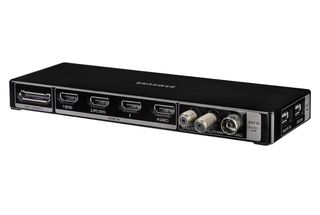
Samsung’s love affair with curved screens continues in the KS9000. While we’re still not entirely sold on the idea, it’s subtle enough that it shouldn’t be a deal-breaker.
Viewing angles are wider than we noticed on last year’s sets thanks to an improved panel, and Samsung’s new Ultra Black Moth Eye filter technology works hard to ensure any distracting reflections are kept to a minimum too.
The KS9000 is a 4K, HDR-capable set that supports Quantum Dot technology for a much wider colour gamut than standard sets. This allows it to reach 93 per cent of the industry-standard DCI-P3 colour space, which puts it comfortably within the boundaries for Ultra HD Premium specification.
It also hits the 1,000 nits of peak brightness needed to carry the UHD Premium logo on its box (and indeed, make the most of the burgeoning HDR content), which is quite an achievement when you consider this set is edge lit.
We’d usually expect this kind of brightness from direct-lit panels, but Samsung has cracked it with edge lighting to keep prices down – a wise move when you consider the eye-watering cost of the KS9800.
MORE: Ultra HD Premium: What are the specs? Which TVs support it?
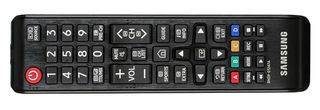
Samsung has had to rearrange its LED backlighting to make it happen though, so they now run horizontally along the top and bottom of the screen rather than vertically down the sides. It’s a risky move.
Horizontal backlighting hasn’t always worked as well as vertical, but save for a few niggles, it has largely paid off here.
3D has been ditched on the KS9000, and on all of Samsung’s 2016 televisions for that matter, meaning if you are one of the few remaining fans of the format, you’ll probably want to look elsewhere for your new set.
Samsung’s Tizen operating system has seen some welcome tweaks this year. It still sits along the bottom of the screen, but it’s now faster and more intuitive, adding a second row of exploded content and suggested next steps from your highlighted selection.
This could mean having a list of sources or quick settings without needing to open up a full settings screen, or more interestingly, suggested content from your Netflix and Amazon watch lists, or YouTube videos from your subscriptions.
MORE: Best TV deals – smart, HD, 4K TV

Sadly, we’re still waiting on all of the UK catch up service apps to be added to the KS9000, though we’ve been promised that iPlayer and ITV Player should be here by the autumn, with 4OD landing before the end of the year.
Bear that in mind if you’re ready to buy before then.
Samsung has nailed the set-up procedure straight out of the box, walking you through the main settings such as channel tuning and network connections so you can’t go far wrong.
MORE: How to watch catch-up TV, video on demand and movies online

The new smart remote ditches point-and-click for a much simpler D-pad, and can be used as a universal remote for all your kit. Though limited to basic commands, we were able to pause, play and skip through our UHD Blu-rays without reaching for the Panasonic DMP-UB900 remote.
Picture controls are hidden away under “expert settings”, leaving more simplistic picture modes like Movie, Standard, Natural and Dynamic front and centre for you to choose from.
We find ‘Movie’ the most natural handler of colour, though for a slightly cooler colour palette, 'Standard' may suit your tastes better.
MORE: A list of all the 4K Ultra HD Blu-ray discs on sale
Picture
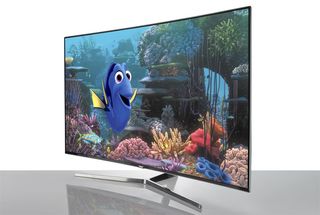
We use our THX Optimizer disc to set the picture levels and turn off all processing from the start – the only thing you might find useful here are the motion controls.
The KS9000 is a very stable set for the most part, but some low blur/judder customising can help smooth out any hiccups you encounter, without any negative affect of the overall picture.
Be aware that these settings will alter the moment the TV recognises an HDR source, in order to optimise the screen for HDR content.
Most noticeably, it will boost the backlight up to the maximum, and we’d recommend leaving it there for best results. In fact, we left all the HDR settings pretty much as they were – they’ll revert back to your saved settings once the HDR source is turned off.
MORE: HDR TV: What is it? How can you get it?
Sure enough, we load a 4K HDR copy of The Martian and the backlight jumps into action. The brightness of which it is capable is impressive, and directs real clout to the highlights of an image, while holding on to the depth and detail you’d usually lose.
This means the orange flames from the rocket’s engine glow fiercely against the dark, stormy background of Mars, but instead of just one hue, it’s a nuanced display that really adds to the realism of the picture.
As the crew search for Mark in the storm, the torch lights on the astronauts’ suits cut a considered but powerful path through the darkness, while still displaying different degrees of intensity from the centre of the torch light to its edges.
There’s real insight here too. Skin tones are superbly worked, outlines are crisp and textures are spot on, whether it’s the rocky surface of Mars or the lines on Jeff Daniels’ face as he talks to the media.
MORE: Panasonic DMP-UB900 vs Samsung UBD-K8500 review
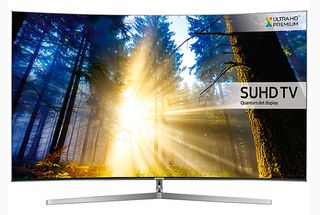
This level of fine detail and subtlety also helps to deliver believable depth to the picture, the vast emptiness of the surroundings only emphasising the desperate loneliness of Mark Watney’s situation.
Colours look stunning too – rich in contrast and impactful – all without looking overdone.
Save for the fact we’d like blacks to go a little darker to bother the likes of the Panasonic DX902, it’s one of the most lifelike LCD pictures we’ve seen, and shadow detail pips that on the Panasonic too.
Talking of black levels, there is a small issue of backlight banding on occasion – most noticeable when a bright object appears in a dark scene and you’re watching a 16:9 film (you’ll get black bars top and bottom of the picture).
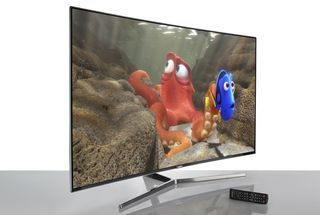
Wherever that object is, you’ll notice that the backlighting at the top and bottom blooms into the black bars a little.
It’s not too distracting unless you’re watching in a dark room and are looking out for it, but it’s a limitation of the edge lighting tech that the KS9000 uses that you should be aware of.
It’s less obvious with SDR content though, mostly because the backlight setting is much lower (we set it to 8 for our room – over half that compared to HDR). This helps blacks go a little darker too, but we’d like them deeper still.
Lowering the backlight further can help, but it has a knock-on effect to shadow detail that we’d rather not give up.
MORE: Ultra HD Blu-ray - the ultimate guide to 4K movies
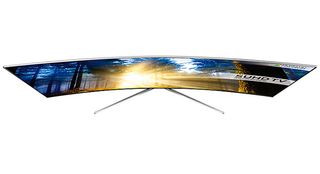
The drop down to standard Blu-ray content doesn’t see a huge shift in character. Detail levels drop somewhat and you won’t get the same level of nuance in highlights as you will with HDR content, but it’s still a wonderfully natural, refined image that’s sharp, well-judged and noise free.
Even terrestrial TV looks good. HD channels fare better, of course, but standard def images are still wholly watchable, and aren’t overly smooth or soft.
Though Samsung seems keen to push it, we’d steer clear from the built-in HDR+ mode, which aims to deliver HDR-esque benefits to SDR content.
It’ll boost the brightness, which is briefly impressive, but ultimately it impacts too much on the subtlety in colours and textures.
We notice it has a negative effect on the set’s otherwise pretty solid motion handling too.
MORE: 10 best Blu-ray discs to test your system
Sound
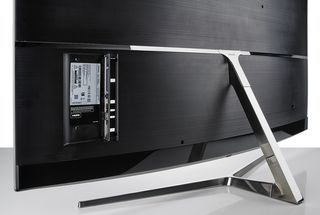
We’re pretty impressed by the sound from a TV this slim, offering 60W of output from a 4.1ch setup. It’s a clean, clear sound with a decent amount of bass weight and the ability to go loud without sounding pushed.
Our only wish is that it was a touch crisper. Samsung has been careful with the levels of treble to stop the set sounding thin or harsh, but we’d like it to loosen the reigns just a little to allow it to be a bit more expressive.
For that reason, we’d still recommend boosting the sound with a soundbar or, better still, a full surround-sound set-up to get its sound as good as its picture.
MORE: Best soundbars 2016
Verdict

In the UE55KS9000, Samsung has kept up the pace following the success of last year’s sets, and delivered a superb TV at a competitive price for its level.
Yes, you will have to accept an edge-lit set and the compromises that come with it, and 3D fans will need to look elsewhere.
But we don’t think that’s enough to take away from what is an otherwise an absolutely stunning picture and performance for the money.
While it's still unclear whether OLED technology will eventually win out in the battle of the sets, for now, the UE55KS9000 shows there’s plenty of life left in the LCD yet.
See all our Samsung reviews

